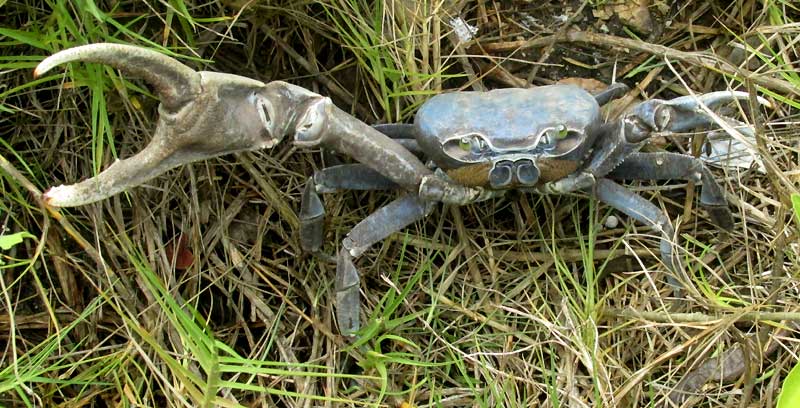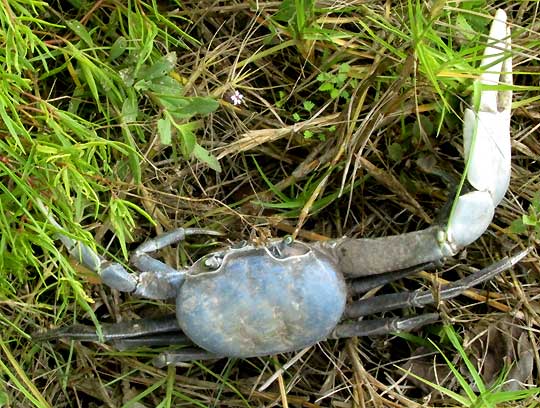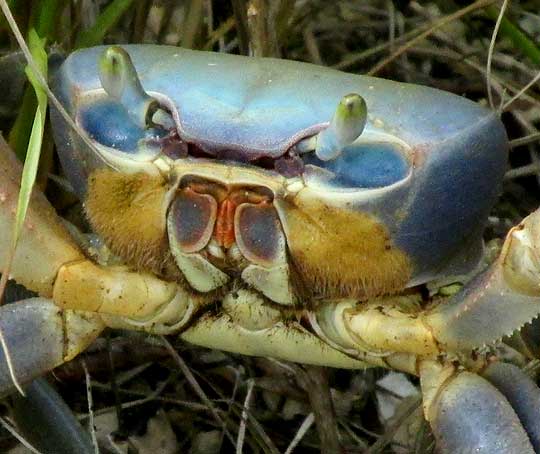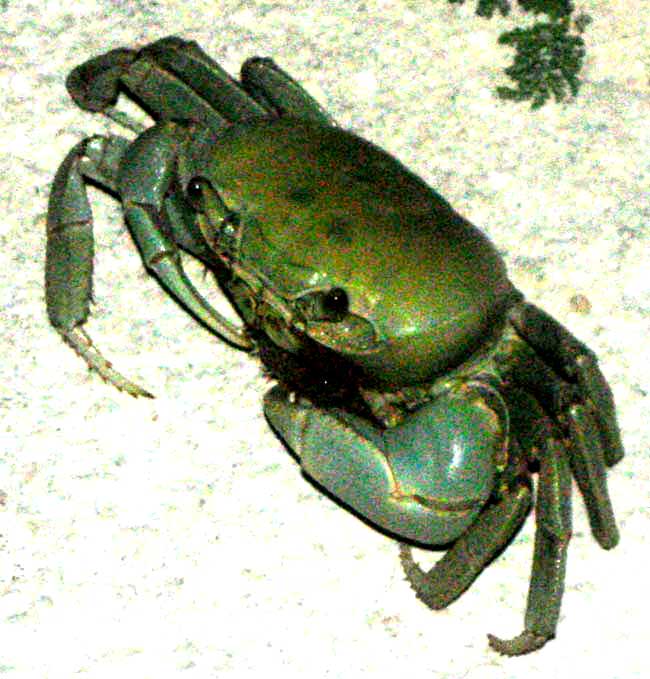Excerpts from Jim Conrad's
NATURALIST Newsletter

from the June 21, 2015 Newsletter issued from Río Lagartos, on the Yucatan Peninsula's northern coast (~N21.60°, ~W88.16°), Yucatán state, MÉXICO
BLUE CRABS
Last weekend's dry-season-breaking heavy rains wrought innumerable changes in the landscape and the lives of local organisms. One change is that this week as I biked along area roads, often I met big Blue Crabs, CARDISOMA GUANHUMI. They seemed to gather at the roadside, though vehicles and my approaching bike caused them to jump back. Maybe they were thinking about crossing the road, but were afraid to do it, and with good cause, because lots of squashed crabs had left greasy splotches on the pavement. And more than one Gray Fox and feral cat had been feeding on crab remnants when they, too, were run over.
Some of these Blue Crabs were big ones. Each male bore one claw much larger than the other, and if I approached too close the crab would turn to face me and threateningly raise his big claw with the pincers open as shown above.
That male was big enough to really hurt a hand or foot, and when I got close for a picture he swung his big claw at me and waved it around. For a better perspective on just how large the claw is, below you can see the above individual from above:

At the ASnailsOdyssey.Com I read that "On a comparative basis, a crab claw exerts greater force during crushing than any force exerted in any other animal activity."
As I kept angling for a closer picture, eventually the crab moved into the mangroves for cover.
Not all Blue Crabs are blue. Some are intensely dark blue, others faded blue, and some are the color of the one shown below:

Blue Crabs collect and eat leaves and fruits close to their burrows, as well as insects and other animals, and carrion. Sometimes they eat one another. During the day they try to stay out of the sun, preferring to forage at night.
You just have to admire any crab's armor, and these Blue Crabs gave me a good look, such as the view shown below:

You wonder at all those mouthparts. At the ASnailsOdyssey.Com site I read that "the large claws ... catch, crush, and tear apart prey. From the claws the food bits are passed to 3 pairs of outer mouth appendages, the maxillipeds. These render and sort the bits, and then pass them to 2 pairs of inner appendages, the maxillae. From the maxillae the food is moved to a single pair of mandibles where, after a final maceration, it is swallowed."
In our picture, the flat, paddle-like objects in the general area where a mouth would be expected are the maxillipeds that "render and sort" bits of food, and pass the bits to the maxillae. You can't see most of the mouthparts because the maxillipeds cover them.
In that shot it's easy to make out the stalked compound eyes. Each compound eye is composed of hundreds of independent light-receiving units, or "ommatidia," each covered with a cuticular lens. Some crabs have long antennae but our Blue Crab's antenna are small, whisker-like affairs hardly visible at the inside-base of each eyestalk.
But, I didn't want to get distracted by all these exotic anatomy features. What was good this week was just seeing so many big crabs along the roads, and wondering what mysterious urge caused them to gather there so nervous about passing cars and bikers.

from the June 19, 2011 Newsletter issued from written at Mayan Beach Garden Inn 20 kms north of Mahahual; Caribbean coastal beach and mangroves, ~N18.89°, ~W87.64°, Quintana Roo state, MÉXICO
ROADSIDE CRAB
Wednesday as the sun was setting the sky was clearer than usual and a full moon was rising in the east, out over the water. Sea turtles are laying eggs about now, and I couldn't imagine a better egg-laying night than that one. In the day's final, dim light I mounted the bike and headed toward a known nesting site.
About halfway there I barely could make out a blocky silhouette inching onto the white sand road. I figured it was a crab, but I didn't really see it until I'd photographed the form with a flash, then viewed the image on the screen. You can see what I came up with at the top of this page.
Because of its large size -- the boxy body was about four inches across (10cm) -- I'd figured that it would be one of the big, blue crabs so often seen along the road in early mornings, so I was surprised by this one's body color, with only its big claws being a little bluish. Well, I knew that volunteer identifier Bea in Ontario would clarify the matter, and she did.
What's in the picture is indeed the Blue Land Crab, CARDISOMA GUANHUMI, despite its color. This species' color can range from dark blue to brown or pale gray.
Blue Land Crabs are distributed from southern Florida along Caribbean coasts to South America. Omnivorous, they eat leaves and fruits close to their burrows, as well as insects, carrion and much more, including other Blue Land Crabs.
Mainly the species is nocturnal. However, finally I'm realizing that many of the rustling, scampering sounds issuing from roadside bushes as I bike down the road on early mornings, instead of being raccoons, coatis and agoutis, which I'd supposed, are Blue Land Crabs. The crabs dig sizable burrows in the sand, often below tree roots, and hang around their den openings. When anything disturbs them, like me on the bike, they stampede across dry leaves into their dens.
By the way, Bea says that you can distinguish land crabs from underwater crabs by the way land crabs have tall, boxy bodies like our Blue Land Crab. Aquatic crabs usually are flatter and more streamlined to prevent them from being knocked about by waves and currents. Also, on underwater crabs the back two legs are usually flattened into paddle-like "swimmerets" used for swimming. On land crabs the back legs are slender like its other walking legs.
I didn't see turtles laying eggs that night. I did find one nest that had just been robbed. A couple of mornings later Marcia found some new nests, some already robbed, and a couple marked with upside-down Coke bottles on wooden sticks, for later robbery. Marcia moved the Coke bottles, so maybe there's hope for those nests.